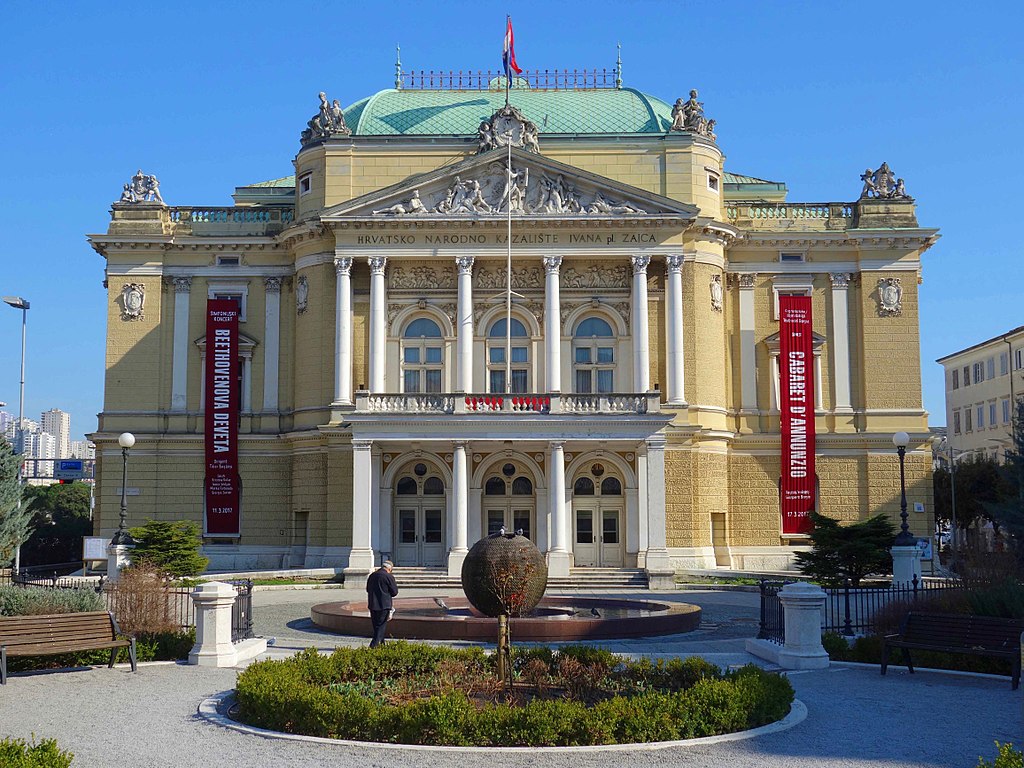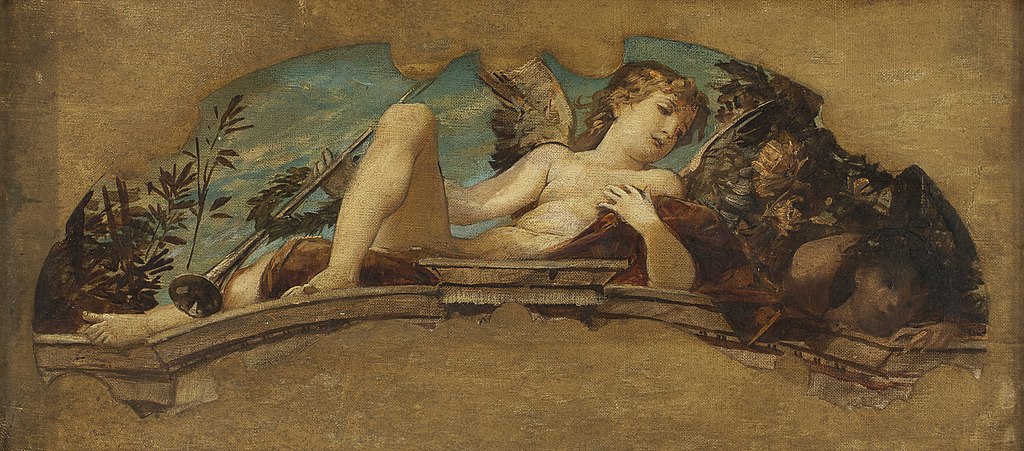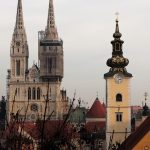Gustav Klimt is undoubtedly one of the most famous artists of all time. Did you know that three of his works have been created specifically to be displayed in Rijeka, Croatia? Not in a museum (not until recently, at least), but mounted on the ceiling of the Croatian National Theatre Ivan Zajc, along with six other works painted by Klimt’s brother Ernst and another Viennese artist, Franz Matsch.
The theatre building in Rijeka was designed by the renowned Viennese architectural studio Helmer and Fellner, specialised for theatres and concert halls. Dozens of cultural landmarks were built after their plans across central Europe in the second half of the 19th century, including the Croatian National Theatre buildings in Zagreb and Varaždin. Out of their three theatre projects in Croatia, the one in Rijeka has the best preserved original form; it was also the first building in Rijeka to get electrical lighting and was equipped with the first telephone in town.

The Croatian National Theatre in Rijeka / Image by Antonio199Cro, Wiki Commons
In 1885, the architects commissioned artworks for the interior from three young Viennese artists who worked together under the name of Art Society (Die Künstler-Compagnie): brothers Gustav and Ernst Klimt, and Franz Matsch. They were all just getting their careers off the ground; Gustav, who would later become the biggest name of the three, was only 23 years old at the time.
The artists were to produce nine large format paintings depicting mythical and historical scenes, widely popular at the time and also thematically suitable for theatre decor. The completed commissioned works were shipped to Rijeka and installed on the ceiling of the auditorium in the new theatre.
All three artists went their separate ways in years following the Rijeka commission. Ernst Klimt died young, in 1892, and was thus deprived of the chance to achieve notable artistic renown. His death also marked the end of the Art Society, as the other two artists decided to part ways and explore different artistic avenues.
Gustav Klimt embraced the groundbreaking Art Nouveau style and eventually became the icon of the revolutionary movement, while Matsch chose the familiarity of the traditional academic milieu, going on to work as a portraitist in the aristocratic circles.
The nine large canvases painted for the theatre in Rijeka provide valuable insight into the early stages of the artists’ careers, especially Gustav Klimt who would in time develop a particularly distinctive style not at all reminiscent of the classical theatrical decor.
A once in a lifetime opportunity
In March and April 1885, right after the three artists completed the commission, the paintings were displayed in the Museum of Art and Industry in Vienna before they were shipped to Rijeka.
In 136 years since the works were painted, this was the single time they were displayed at ground level, in a museum environment where they could be admired by the public.
As soon as they arrived in Rijeka, they were mounted on the ceiling of the auditorium in the new theatre and remained at a height of some 20 metres above ground for over a century. While technically visible from the auditorium, one would have to strain their neck significantly trying to make out the main motifs of the paintings; they fit superbly into the grandeur of the ornate theatrical decor, but it’s not the optimal way to appreciate the likes of Klimt.
The paintings were restored once before as part of a larger scale renovation of the theatre building in 1978, but were not displayed publicly at the time.
And then came 2020 and a grand exhibition at the Sugar Palace of the Rijeka City Museum. Unknown Klimt: Love, death, ecstasy literally provides a once in a lifetime opportunity to see the precious works up close and admire the intricate details.

Ernst Klimt, Genius With a Trumpet
In the preparatory stages of the exhibition planning, the nine paintings were dismantled from the theatre ceiling in 2018 and have undergone a thorough restoration. Works by Gustav Klimt and Matsch were restored by Ana Rušin Bulić and Goran Bulić at the Rijeka department of the Croatian Restoration Institute, while those created by Ernst Klimt were shipped to the Easel Painting Department of the Croatian Restoration Institute in Zagreb where Slobodan Radić performed restorative works.
Once the exhibition closes and the canvases are installed back on the theatre ceiling where they belong, we’re unlikely to get another chance to admire them up close in our lifetime. Unknown Klimt was originally supposed to close in late 2021, but due to popular demand the exhibition was extended and will remain open until March 31st, 2022.
If the road takes you to Rijeka – the upcoming carnival in February could be a nice motivator to visit – we urge you to stop by the Sugar Refinery Palace and avail of this rare opportunity to see the early works of the world famous master and his fellow artists.
Make sure to also check out the superb permanent exhibit at the Rijeka City Museum at the same location; it’s a must-see spot in Rijeka and is included in the ticket for the Klimt exhibition.
The following nine works made for the Rijeka theatre are displayed at the exhibition Unknown Klimt:
Gustav Klimt:
St. Cecilia
Anthony and Cleopatra
Orpheus and Eurydice
Ernst Klimt:
Allegory of Theatrical Art
Genius with a trumpet
Genius with a basket of flowers
Franz Matsch:
Allegory of Love Poetry
Allegory of Dance
Allegory of Comic Opera
Learn more about the exhibition at the Rijeka City Museum website.









